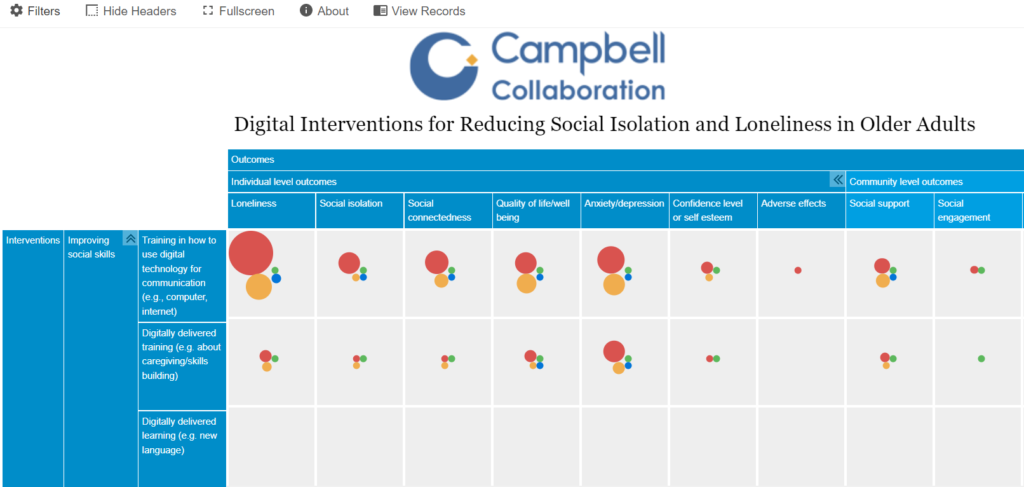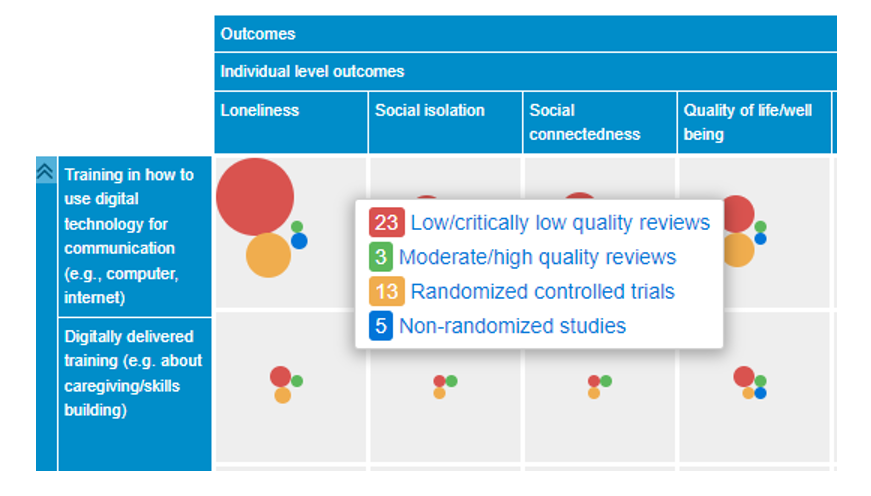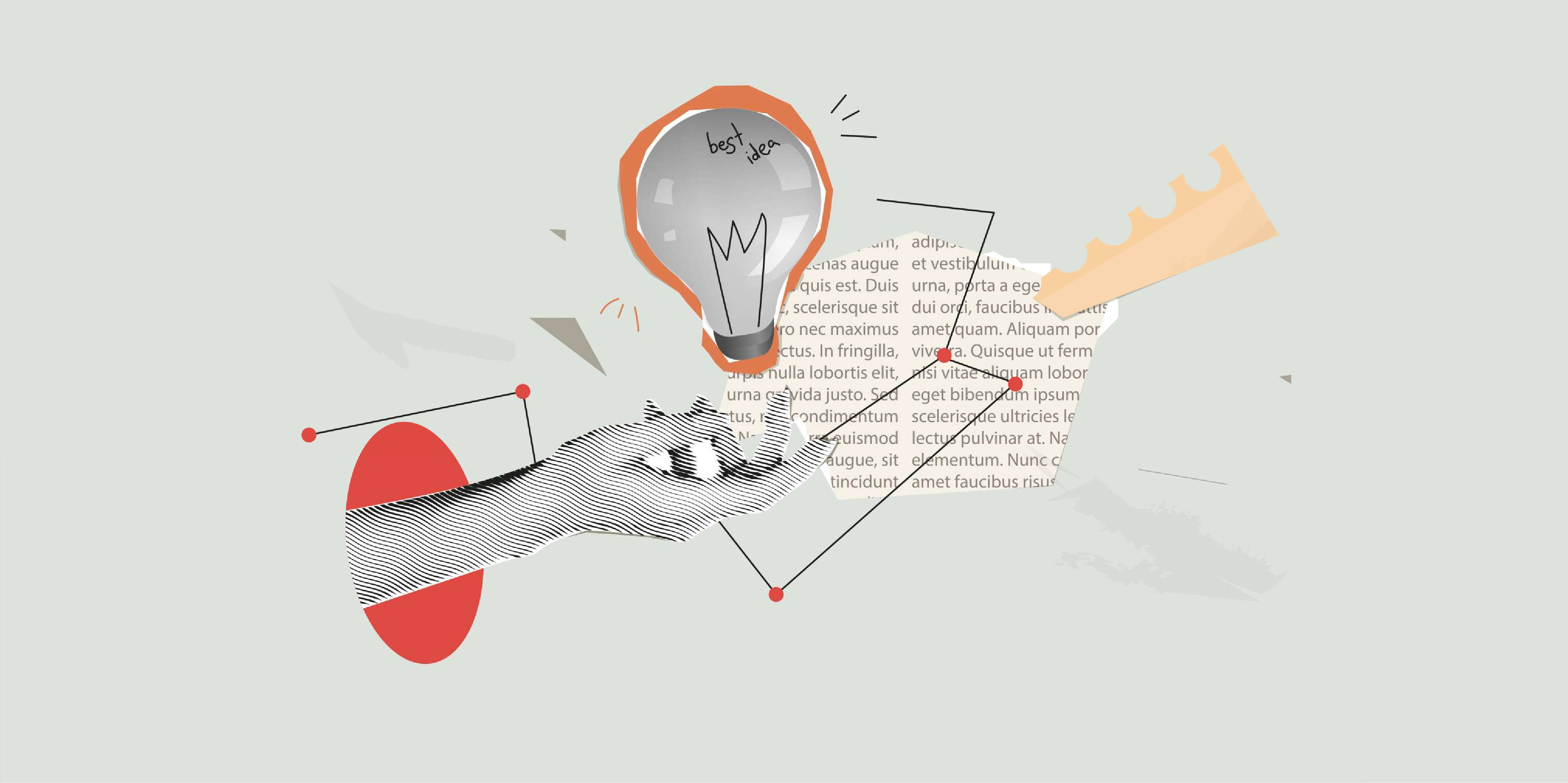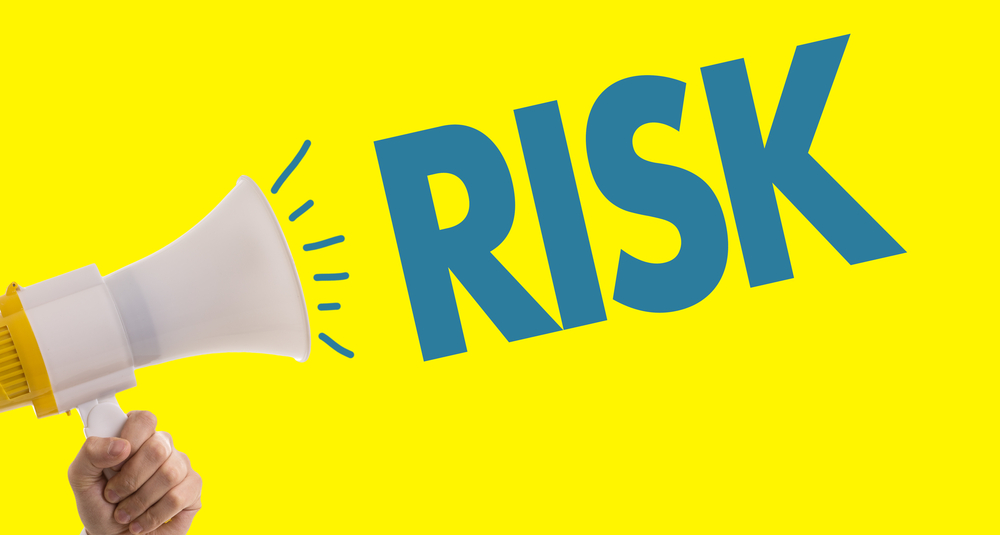What are evidence gap maps and why are they important?
Posted on 18th November 2022 by Carolina Guadalupe Cruz Muñoz

Evidence gap maps (EGMs) are graphic representations of the available systematic reviews and ongoing research on relevant topics, as well as impact evaluations of interventions and its outcomes. They aim to present this information in an intuitive and interactive format.
They are important because evidence – such as systematic reviews, ongoing studies and protocols – is available in different databases, websites and journals. This represents a barrier to making the best evidence-based decisions on a problem or policy since the researcher or policymaker not only has to collect all the information, but also analyse and compare it in order to determine which decision is the best to make.
The importance of these gap maps lies in their effectiveness to show the “gaps” on the existing evidence: not only which interventions have been done, but also which interventions, evaluations or outcomes have either little to no impact nor information available.
Another way of explaining them is in the words of the Campbell Collaboration in its EGMs-related webpage:
EGMs show what evidence there is and not what evidence says.
This is a good time to mention that some organisations, such as the Campbell Collaboration, refer to EGMs as ‘Evidence AND gap maps’ to clearly show that these maps contain both existing evidence and gaps in the evidence.
The anatomy of an Evidence gap map
Let’s have a look at some examples of EGMs so we can better understand them. A classic EGM will be a matrix with the following components:
- Rows: they display the interventions.
- Columns: they display the outcomes.
- Circles or bubbles: represent the evidence, namely the number of studies or reviews. These bubbles have 2 characteristics: size and colour. Size represents the relative number of studies, whereas colour is used to represent the type of study (colour choice will vary).
For example, in this EGM from the Campbell Collaboration on the topic ‘Digital interventions for reducing social isolation and loneliness in the elderly’ (Figure 1) the interventions (shown in the rows) consist of training in how to use technology, digitally delivered training or digitally delivered learning, and the outcomes evaluated (shown in the columns) include: loneliness, anxiety, depression and self-esteem, among others. From this EGM, we can observe that there is no evidence available on the adverse effects of delivering training in a digital manner, and none for digitally delivered learning either. As mentioned in the introduction, this does not mean that digitally delivered learning does not reduce social isolation in the elderly, but that reviews or studies evaluating this type of intervention were not found: there is a gap in evidence.
Using the same example EGM, Figure 2 shows that each colour represents a type and quality of the studies, while the size of each circle is proportional to the number of each one of them. This is extremely helpful since not all studies are equal in quality. Therefore, we can conveniently access the best available evidence. In this case, only three moderate/high quality systematic reviews relating to e-communication and its effect on loneliness were found. Using this EGM in particular, I effortlessly had access to them without searching and reading the rest of the available studies.
Beyond visuals and saving time: urgent policy-making and developing studies that matter
Evidence gap maps’ development is relatively faster than systematic reviews: all the available studies can be included in the EGM even if they’re still not complete (Snilstveit et al, 2016). Since some policies and decisions need to be taken as fast as possible, EGMs are definitely a valuable resource. Moreover, identifying which evidence gaps exist allows researchers to conduct studies aimed at filling these specific gaps.
For example, if we analyse this UNICEF EGM on Child and adolescent mental health and psychosocial support interventions in low and middle-income countries, we can identify a gap in research on externalizing problems such as conduct disorder and attention deficit hyperactivity disorder (ADHD). So, we know that efforts should be put on conducting studies on interventions in those disorders.
Putting what we learnt into practice
Let´s have a look at this EGM on Health, Social and Technological Interventions to Improve Functional Ability of Older Adults. Looking at the map, can you find the answers to the following questions?
- How many randomised control trials (RCTs) are there on rehabilitation services and its impact on neuro-musculoskeletal function? And how many high quality systematic reviews?
- How many RCTs are there about family and caregiver support on mental functions? How many systematic reviews and what is their quality?
- How many high quality systematic reviews are available on visiting health professionals and its impact on falls?
The answers are at the bottom of the blog!
If you’re interested in looking at more examples of Evidence Gap Maps, I recommend you visit the following websites:
- UNICEF: Here you can look at EGMs on child and adolescent wellness, specifically in low and middle-income countries.
- International Initiative for Impact Evaluation: Here you can find EGMs on evidence-informed equitable, inclusive and sustainable development.
- Cochrane-Campbell Global Ageing Partnership Evidence and Gap Maps: Here you can look at two EGMs: the one I used as an example (on digital technology to mitigate social isolation and loneliness for older adults) and another one about health and social care at home.
You may also be interested in this blog on Evidently Cochrane which summarises the key messages from a map on home-based health and social care and mobility interventions to improve the functional ability of older adults living at home.
References (pdf)
Answers:
- There are 105 RCTs and 2 high quality systematic reviews on the impact of rehabilitation services on neuro-musculoskeletal function.
- There are 5 RCTs about the impact of family and caregiver support on mental status, and 3 low/critically low systematic reviews on the same matter.
- There are 2 high quality systematic reviews on visiting health professionals and its impact on falls.
Did you get them right?





